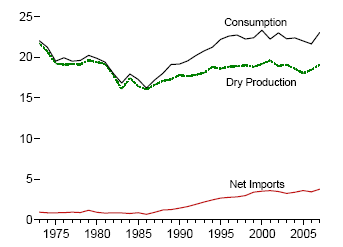|
Natural Gas Supply
|
||||||
|---|---|---|---|---|---|---|
|
Last Updated: October 2008
Next Update: February 2009 What is natural gas? Natural gas is a combustible gaseous mixture of hydrocarbons, mostly methane. It is produced from wells drilled into underground reservoirs of porous rock. Natural gas withdrawn from the well may contain liquid hydrocarbons and nonhydrocarbon gases. The natural gas is separated from these components near the site of the well or at a natural gas processing plant. The gas is then considered “dry” and is sent through pipelines to a local distribution company, and ultimately, to the consumer. Dry natural gas is also known as consumer-grade natural gas. In addition to natural gas production, the U.S. gas supply is augmented by imports, withdrawals from storage, and by supplemental gaseous fuels.
Natural gas imports Natural gas imports in 2006 totaled 4.2 Tcf which is the equivalent of 19.0 percent of total U.S. natural gas consumed. The majority (86 percent) of those imports came from Canada through pipelines and totaled 3.6 Tcf in 2006. Liquefied natural gas (LNG) The second major natural gas import source was from Trinidad on specially designed ships as liquefied natural gas (LNG). LNG is natural gas that is cooled to minus 260 degrees Fahrenheit at which point the gas becomes a liquid. The volume of the liquid is 600 times smaller than the gaseous form. Total 2006 LNG imports were 584 Million cubic feet (Mcf). Natural gas storage There were 397 active underground storage fields (salt fields, aquifers, or depleted fields) in the United States during 2006. Natural gas is injected into these fields primarily during April through October and withdrawn during November through March. The volume of working gas in storage during 2006 ranged from 1.6 Tcf at the end of March to 3.4 Tcf at the end of October. Supplemental gas supplies include blast furnace gas, refinery gas, propane-air mixtures, and synthetic natural gas (which are manufactured from petroleum hydrocarbons or from coal) and totaled 66 Billion cubic feet (Bcf) in 2006. The single largest source of synthetic gas is the Great Plains Synfuels Plant in Beulah, North Dakota.
The outlook for U.S. future natural gas supply Total U.S. natural gas production grows from 18.5 trillion cubic feet in 2006 to 19.4 trillion cubic feet in 2030, as depletion of the onshore lower 48 conventional resource base is offset by increased production from unconventional sources and from Alaska. Offshore production increases from 3.0 trillion cubic feet in 2006 to 4.5 trillion cubic feet in 2017, then declines to 3.5 trillion cubic feet in 2030. Production in shallow waters declines slowly through 2030. Production in deeper waters rises to 3.0 trillion cubic feet in 2019 and then declines through 2030. Net Imports of Liquefied Natural Gas Grow in the Projection Net U.S. imports of natural gas from Canada are projected to decline, and net imports of liquefied natural gas (LNG) are projected to grow, from 2006 through 2030. Most of the expected growth in U.S. natural gas imports is in the form of LNG. The total capacity of U.S. LNG receiving terminals increases from 1.5 trillion cubic feet in 2006 to 5.2 trillion cubic feet in 2009 in the reference case (with no further increase through 2030), and net LNG imports grow from 0.5 trillion cubic feet in 2006 to 2.8 trillion cubic feet in 2030 2005 World Natural Gas Production World production of dry natural gas was dominated by the United States (18.1 Tcf) and Russia (22.6 Tcf), whose combined gross production accounts for about 40 percent of the 101.5 Tcf produced in 2005.
More information on this subject can be found in the following EIA publications:
|
||||||
